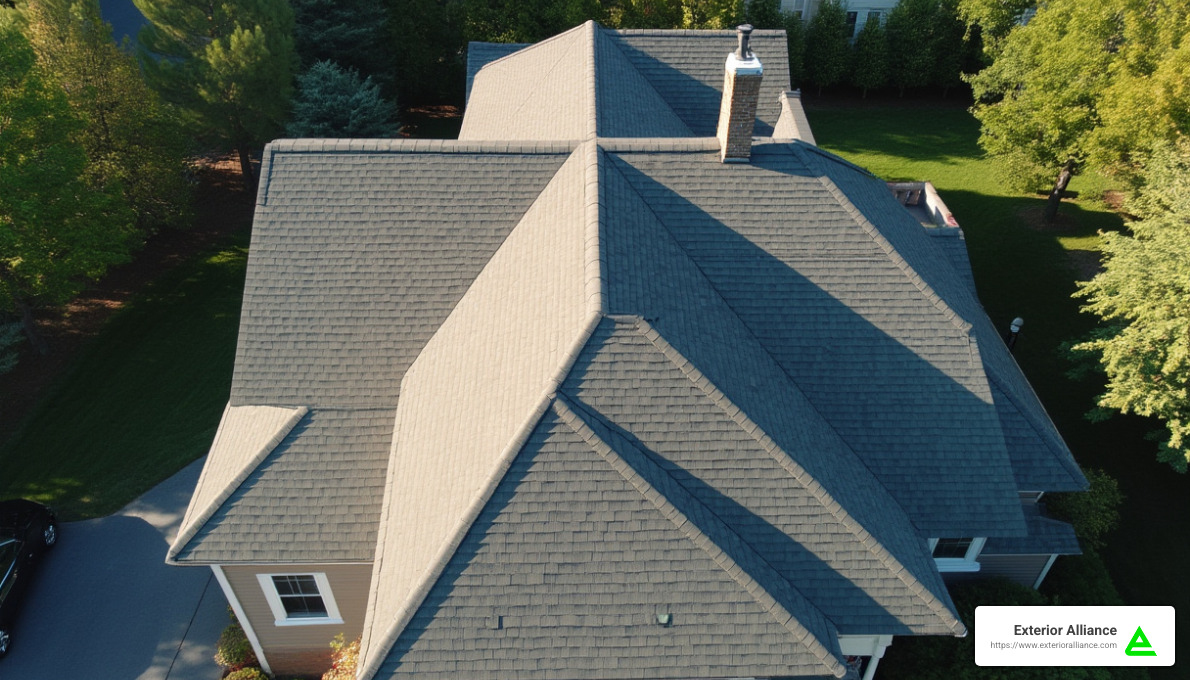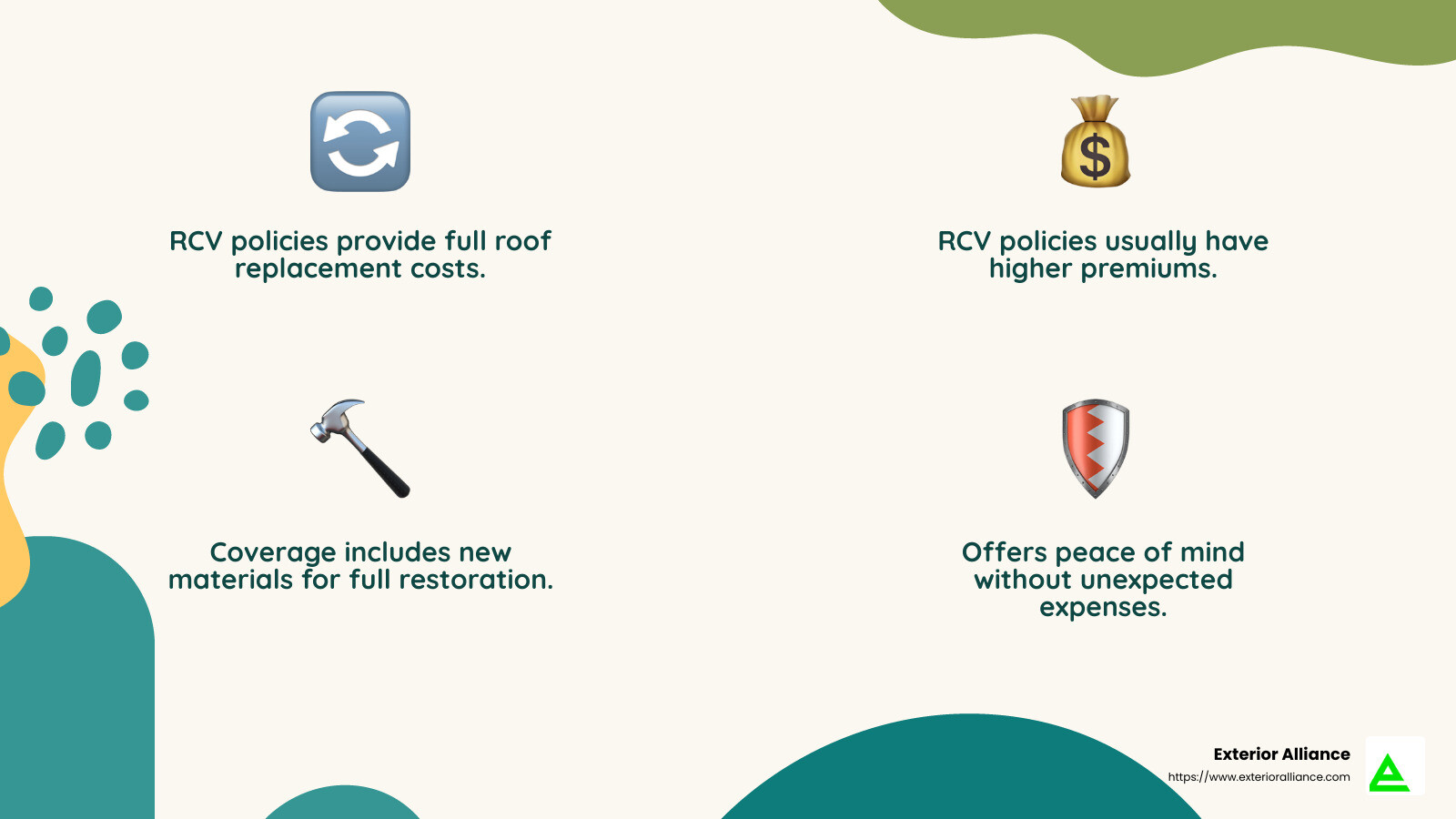
When it comes to protecting your roof, understanding your insurance policy is crucial. Homeowners often find themselves navigating the intricate world of RCV vs. ACV vs. RPS to determine the best coverage for their needs. Let’s break it down simply:
- RCV (Replacement Cost Value): Covers the total cost of replacing a damaged roof, ensuring you receive enough to restore your roof fully without considering depreciation.
- ACV (Actual Cash Value): Considers depreciation, meaning the older your roof, the less insurance will cover, often leading to higher out-of-pocket costs for replacements.
- RPS (Roof Payment Schedule): Offers a structured payment plan without a deductible, typically more affordable but with certain limitations on coverage types and roof materials.
In brief, choosing between RCV, ACV, or RPS depends on your financial needs, the condition and age of your roof, and the level of risk you’re comfortable with.

Understanding RCV, ACV, and RPS
When it comes to roofing insurance, RCV, ACV, and RPS are terms you’ll encounter often. Let’s explain these insurance terms and understand their coverage differences.
Replacement Cost Value (RCV)
RCV is like having a safety net when your roof is damaged. It covers the full cost to replace your roof without considering its age or wear and tear. This means if your roof needs replacing, you get enough money to restore it to its original condition with new materials.
RCV policies usually come with higher premiums, but they provide peace of mind knowing that you won’t have to dip into your savings for unexpected roofing expenses. As one case study showed, a homeowner with an RCV policy was able to replace their $12,000 roof without any out-of-pocket expenses beyond their deductible.

Actual Cash Value (ACV)
ACV, on the other hand, factors in depreciation. This means your payout is based on the roof’s current market value, accounting for age and condition. If your roof is older, the insurance company will pay less, leaving you to cover the rest.
ACV policies often have lower premiums, making them attractive if you’re looking to save on monthly costs. However, the downside is potentially higher out-of-pocket expenses when you file a claim. Imagine having a 10-year-old roof; the insurance might only cover half of the $15,000 replacement cost.
Roof Payment Schedule (RPS)
RPS is a bit different. It offers a payment schedule without requiring a deductible, which can make budgeting easier. These policies are generally more affordable but come with specific limitations. For instance, they might not cover certain roof types, like metal roofs, or might only pay a percentage of replacement costs based on the roof’s age.
RPS can be a good fit for those who want lower premiums and don’t mind the trade-offs in coverage. It’s popular among commercial property owners who plan regular roof replacements every 10-15 years.
Choosing between RCV, ACV, and RPS hinges on your financial situation, roof’s condition, and risk tolerance. Understanding these differences will help you pick the right policy for your home.
Next, we’ll dig deeper into each of these coverage types, starting with Replacement Cost Value (RCV).
Replacement Cost Value (RCV)
Replacement Cost Value (RCV) insurance is like a financial shield for your roof. It covers the full cost of replacing your roof with new materials, without considering depreciation. This means if your roof is damaged, RCV ensures you get enough money to restore it to its original state, regardless of its age or condition.
RCV policies typically come with higher premiums. This is because they offer more comprehensive protection. You’re paying a bit more each month, but in return, you gain peace of mind. You know that if something happens to your roof, you won’t have to dig deep into your savings to cover the costs.
A real-world example helps illustrate this: A homeowner with an RCV policy faced a $12,000 roof replacement. Thanks to their policy, they didn’t have to pay anything out-of-pocket beyond their deductible. This highlights the financial security RCV can offer, especially when unexpected damage occurs.
In the next section, we’ll explore Actual Cash Value (ACV) coverage and how it differs from RCV.
Actual Cash Value (ACV)
When it comes to Actual Cash Value (ACV) insurance, think of it like buying a used car instead of a new one. ACV policies consider the depreciated cost of your roof, which means they take into account factors like age, wear and tear, and even obsolescence. So, if your roof is damaged, the insurance company pays you what your roof is worth at the time of the loss, not what it would cost to replace it brand new.
This approach often results in lower premiums. ACV policies are generally cheaper than RCV policies because they provide less coverage. You’re saving money on your monthly insurance bill, but there’s a trade-off.
The downside? You might face significant out-of-pocket expenses. Since ACV only covers the depreciated value, you’ll need to pay the difference between the insurance payout and the actual replacement cost of your roof. For instance, if your roof has depreciated by $5,000, that’s money you’ll have to cover yourself, plus your deductible. This can be a big financial hit, especially if the damage is extensive.
Consider the Johnson Family from our earlier story. They had an ACV policy, and when their $15,000 roof was damaged, depreciation and their deductible left them with just $4,000 from insurance. The remaining $11,000 came out of their pocket. This example clearly shows the potential financial burden of ACV coverage.
In the next section, we’ll dig into the Roof Payment Schedule (RPS) and how it compares to both RCV and ACV.
Roof Payment Schedule (RPS)
When it comes to Roof Payment Schedule (RPS) insurance, think of it as a custom option for those who want to manage their roof repair costs without the hassle of a deductible. Unlike other policies, RPS can be more affordable because it often comes with no deductible.
Fair Market Value Coverage
RPS policies focus on the fair market value of your roof. What does this mean? Basically, they cover the cost of repairing or replacing your roof based on current market prices for materials, up to the limit of your coverage. It’s like getting a fair deal on a repair job, but with some limitations.
Residential and Non-Residential Structures
RPS isn’t just for homeowners. It can also apply to small apartment buildings, business offices, churches, or educational facilities. This makes it a versatile choice for different property types. However, certain roofs, like flat or metal ones, might not be covered. So, if you have a unique roof, check with your insurer.
No Deductible, But Be Aware
One of the appealing aspects of RPS policies is the no deductible feature. This means you won’t have to pay out-of-pocket before your insurance kicks in. However, keep in mind that RPS usually covers a portion of the repair costs. You might still be responsible for a significant amount if your roof is old or in poor condition.
For example, if repairs cost $10,000, an RPS policy might cover 60% of that, leaving you with $4,000 to handle. While this is better than paying the full amount, it’s crucial to understand the limits of your policy.
In the next section, we’ll tackle some Frequently Asked Questions about RCV, ACV, and RPS to help you make informed decisions about your roof insurance options.
Frequently Asked Questions about RCV vs. ACV vs. RPS
What is an RPS insurance policy?
An RPS (Roof Payment Schedule) policy is like a custom suit for your roof insurance needs. It’s designed to help manage repair costs by focusing on the fair market value of your roof. This means the policy pays based on current prices for materials and labor, but it often covers only a portion of the total cost.
RPS policies are popular because they generally come with no deductible. This can make them more affordable upfront. However, they might not cover all types of roofs, like metal ones, so always check with your insurer.
Is ACV or RCV better?
Choosing between ACV (Actual Cash Value) and RCV (Replacement Cost Value) depends on your personal needs and financial situation.
- ACV policies consider depreciation. They pay for the roof’s value at the time of the claim, which usually means lower premiums but higher out-of-pocket expenses if you need repairs.
- RCV policies cover the full cost to replace your roof without factoring in depreciation. This means higher premiums but less financial burden when you file a claim.
If you’re looking for lower monthly payments and don’t mind covering some costs yourself, ACV might be the way to go. But if you want peace of mind and comprehensive coverage, RCV is usually the better choice.
How to tell if your policy is ACV or RCV?
To figure out if your policy is ACV or RCV, you’ll need to dive into the details of your insurance documents. Look for terms like “depreciation handling” or “full replacement cost.”
- ACV policies will mention depreciation and might list how much value your roof loses each year.
- RCV policies will focus on covering the entire replacement cost without deductions for age or wear.
If you’re unsure, contact your insurance agent. They can explain the specifics and help you understand what your policy covers.
In the next section, we’ll explore the Conclusion to wrap up our discussion on these insurance options and how Exterior Alliance can support your roofing needs.
Conclusion
Navigating roofing insurance can be tricky, but understanding terms like RCV vs. ACV vs. RPS can make a big difference when you’re deciding on the best coverage for your home. At Exterior Alliance, we’re here to help you make informed decisions about your roofing needs.
Our Expertise
With our solid reputation and BBB-accredited A+ rating, Exterior Alliance is more than just a roofing company. We’re your trusted partner in Dublin, Ohio, specializing in both residential and commercial roofing. Our team is experienced, trained, and insured, ensuring your roofing project is in capable hands.
Informed Decisions
Choosing the right insurance policy is crucial. Whether you’re leaning towards the comprehensive coverage of an RCV policy, the cost-effective approach of an ACV policy, or the custom fit of an RPS policy, understanding your options helps you make the best choice for your situation.
Remember:
- RCV offers full replacement costs, ideal if you want peace of mind.
- ACV can save you on premiums but may lead to higher out-of-pocket costs.
- RPS is a good fit for specific situations and can be more affordable upfront.
Our goal is to equip you with the knowledge you need to confidently steer your insurance options. By understanding the differences between these policies, you can choose the one that aligns with your financial and coverage needs.
If you have any questions or need further assistance, don’t hesitate to reach out. At Exterior Alliance, we’re committed to helping you achieve the roof of your dreams and ensuring you have the coverage you deserve.

